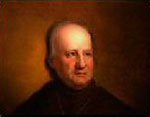
Mother Seton House
The grounds surrounding this house at the time consisted of the buildings of St. Mary’s Seminary and College, the Chapel, a cemetery, and an apple orchard. One mile or so from the city harbor, this section of Baltimore City was very much considered “in the country.”
Brief History of Elizabeth Ann Seton
At the age of 19, Elizabeth married William Seton, the son of a wealthy New York shipping merchant and banker.
William Seton’s shipping and banking business went bankrupt in the early 1800s due to Napoleon Bonaparte’s blockade against British and American merchant ships in the Mediterranean Sea. To aggravate the young family’s hardships, William Seton was in very poor health. The Filicchi family, William Seton’s business partners in Leghorn, Italy, invited the Seton family to visit at their home in hopes that the more moderate Italian climate would be beneficial to William’s health. So it was that in 1803 William, Elizabeth, and their eldest child, Anna Maria, set off on the long and dangerous voyage. The other four children remained with family in New York.
Because of William’s illness, the family was not allowed to disembark for several days. When finally brought onto land, they were placed in a dank quarantine cell near the coastline. These conditions only weakened his poor health even further, and he died on December 27, 1803, after a stay of only five weeks. William Seton was buried in the cemetery at Leghorn. During his weeks in quarantine, the Filicchi family brought food and blankets and some furnishings to William’s cell, where Elizabeth and Anna Maria also stayed. The Filicchi family servants also attended to the Seton family’s needs during this time.
The Filicchi family invited Elizabeth and her daughter to stay with them at their home until safe transportation back to the U.S. could be arranged. They stayed as guests of the Filicchi family for about five months. The Filicchi family were devout Catholics, with a chapel in their grand home. During this stay, Elizabeth was entranced by the daily celebration of Mass in the family chapel, which she attended even though she was not Catholic.
After returning to New York, Elizabeth began formal instruction in the Catholic faith, which caused great concern within her family and her late husband’s family. This left her financially destitute. Elizabeth attempted to start a small boarding school in New York, but because of the deep prejudice against her as a Catholic, few families would entrust their children to her school for fear that she would try to convert the children to Catholicism.
Sulpician Father DuBourg, President of St. Mary’s College & Seminary, founded in 1791, encouraged her to move to Baltimore and establish a boarding school for girls. It was the Sulpician Fathers who offered her the use of this newly built house for her school.
During her year in this house, Elizabeth Seton made her decision to take the vows of a Daughter of Charity. She made her first profession of vows in the Lower Chapel on March 25, 1809, the Feast of the Annunciation. It was Bishop Carroll who first called Elizabeth “Mother Seton.”
On June 22, 1809, Mother Seton and four young women who also took vows as postulants that Spring, left Baltimore for Emmitsburg, where she would found a permanent school for girls. Mother Seton was able to purchase St. Joseph’s Valley, now part of Emmitsburg, Maryland, with a gift she received from a seminary student named Samuel Cooper.
Mother Seton felt comfortable in this new wilderness location because of the faithful presence of Sulpician Fathers at Mount St. Mary’s College and Seminary (founded in 1808). Priests of the Society of St. Sulpice served as her spiritual director and confidant as she began her young community and educational mission in Emmitsburg.
Her year at 600 North Paca Street, though brief, was a time of grace as Elizabeth, her dream, and her legacy were being formed.















